The best Nikon wide-angle zoom lenses in 2022: top DSLR and Z-mount options

The best Nikon wide-angle zoom lenses come in three types. Nikon DX lenses are made for Nikon's APS-C (DX) format cameras, Nikon FX lenses are for Nikon's full frame DSLRs, and there's a third category of Nikkor Z lenses for Nikon's latest mirrorless cameras. We've created separate sections for each below.
Related articles
• Best Nikon lenses
• Best Nikon Z lenses
• Best fisheye lenses
• Best wideangle lenses
• Best Nikon cameras
• Best Nikon camera bags
Pairing a wide-angle zoom lens with your Nikon camera allows you to fill the frame with your subject. You can produce a wide perspective that's perfect for landscapes, cityscapes and architecture. Wide-angle lenses are also often nice and small, making them ideal for travel and for shooting situations where space is limited. For example if you’re shooting indoors and constrained by walls and other obstacles, a wide-angle zoom can be a massive help.
Get close to your subjects and you can exaggerate perspective, or back out to cram in as much context as possible. A wide-angle zoom gives you the best of both worlds, and if you're still building your lens collection it's one of the best Nikon lenses you can get. However, whatever kind of lens you’re buying, it always pays to buy a good one. The good news is that you don't have to pay over the odds, and many great lenses are available for knock-down prices.
One thing to bear in mind, however, is that a lens's focal length does depend on the camera you pair it with. FX-format (i.e. full frame) lenses can be paired with Nikon cameras with full-frame or APS-C sensors (known as FX and DX cameras), however, the smaller APS-C DX sensor will change the angle of light entering the camera and extend its focal length. So, a lens that's wide on a full-frame FX camera won't be as wide on a DX-format camera. Always check what kind of camera you're using and make your choice accordingly.
In this guide we've included dedicated FX-format lenses, as well as DX-format lenses designed specifically for APS-C cameras. We've also added a section for the Nikon mirrorless Z-mount system.
Here’s our guide to the best-buy wide-angle zooms for Nikon on the market.
Nikon DX wide-angles
The best Nikon wide-angle zoom lenses for Nikon DX DSLRs, such as the Nikon D3500, Nikon D5600 or D7500and Nikon D500.
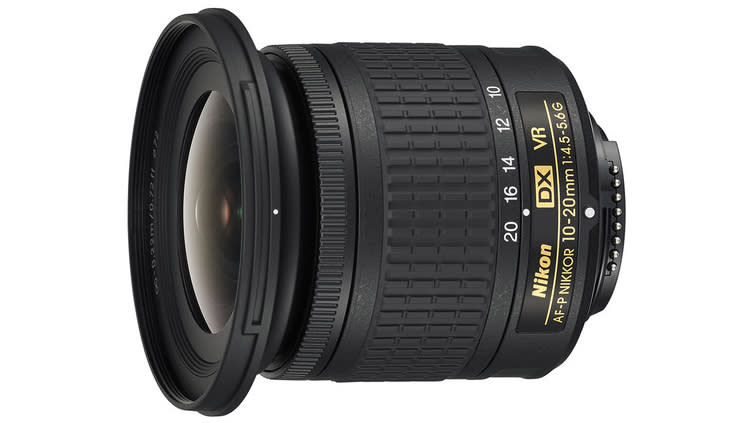
1. Nikon AF-P DX 10-20mm f/4.5-5.6G VR
Small, simple and light, this makes an ideal ultra-wide travel lens
Mount: Nikon F DX | Full-frame compatible: No | Autofocus type: Stepping Motor | Stabilizer: Yes | Minimum focus distance: 0.22m | Filter thread: 72mm | Dimensions (WxL): 77x73mm | Weight: 230g
Compact and lightweight design
Includes Vibration Reduction
Plastic mounting plate
No focus distance scale
This wide-angle zoom is refreshingly small and lightweight. To put it into context, both the competing Sigma DX format lenses are more than twice as heavy as the Nikon. There’s a catch though, in that the mounting plate is plastic rather than metal, and the overall build feels much less robust, but that's the price you pay for improved portability.
Unlike Nikon’s older DX format wide-angle zooms, this one adds VR (Vibration Reduction), with a 3.5-stop effectiveness in beating camera shake. There’s also a virtually silent AF-P stepping motor autofocus system, which works well for stills and movie capture alike. However, this does make both autofocus and manual focusing impossible with a number of older DSLRs, and there’s no focus distance scale.
Sharpness is very good at the centre of the frame but drops off noticeably towards the corners. Performance could be better in terms of distortion and color fringing but, overall, it’s a neat and very travel-friendly lightweight zoom.
See our full Nikon AF-P DX 10-20mm f/4.5-5.6G VR review
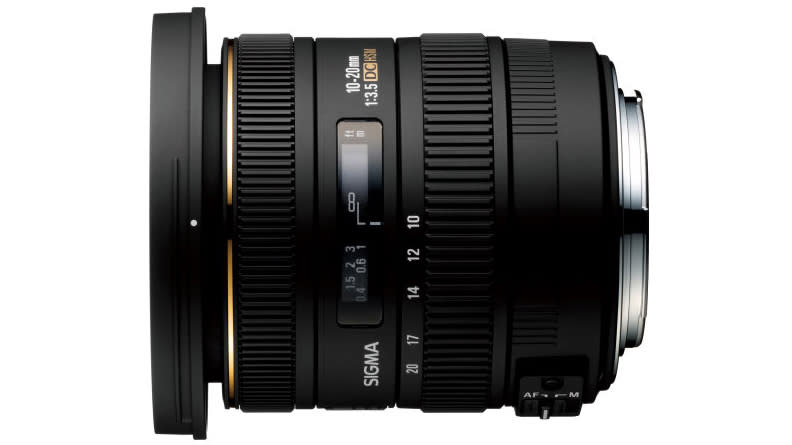
2. Sigma 10-20mm f/3.5 EX DC HSM
A long-running favorite, but it's getting harder to find
Mount: Nikon F DX | Full-frame compatible: No | Autofocus type: Ultrasonic (ring-type) | Stabilizer: No | Minimum focus distance: 0.24m | Filter thread: 82mm | Dimensions (WxL): 87x88mm | Weight: 520g
High-performance autofocus system
Constant f/3.5 aperture
Filter thread is large at 82mm
It’s not weather sealed
In the past this has been our go-to DX format ultrawide zoom, but it's now been officially discontinued is therefore getting harder to find. The second of Sigma's DX format 10-20mm zooms, this lens is larger than the original, but has a constant rather than variable aperture rating. In this respect, it’s similar to the Tokina 11-20mm lens (below), although the Sigma is two-thirds of an f/stop slower.
Premium glass includes two ELD (Extraordinary Low Dispersion) elements plus an SLD (Special Low Dispersion) element. Despite costing about the same as Nikon’s budget 10-20mm lens, this Sigma feels much more solid and sturdy. It has a fast and whisper-quiet ring-type ultrasonic autofocus system and, unlike Sigma’s 8-16mm lens, it has a filter attachment thread and removable hood.
Sharpness is impressive, especially in the central region of the frame, while colour fringing and distortions are particularly minimal. For a high-performance, top-value DX format lens, it can’t be beaten, IF you can still find one!
See our full Sigma 10-20mm f/3.5 EX DC HSM review

3. Tokina atx-i 11-16mm f/2.8 CF
Great image quality and a constant f/2.8 maximum aperture
Mount: Nikon F DX | Full-frame compatible: No | Autofocus type: Electric motor | Stabilizer: No | Minimum focus distance: 0.3m | Filter thread: 82mm | Dimensions (WxL): 84x89mm | Weight: 555g
Good image quality and fast f/2.8 aperture
Fixed physical length during focus and zoom
Relatively limited zoom range
Not everyone’s a fan of push-pull focus rings
The original edition of Tokina’s ATX 11-16mm was one of the first ultra-wide zooms for DX format Nikon DSLRs. The Mark II edition added an internal autofocus motor, enabling autofocus on entry-level bodies like the D40 and later D3000 and D5000 series cameras, which lack in-body AF drive. This most recent version is from Tokina’s ‘atx-i’ stable, ‘i’ standing for ‘interactive’ mutual communication between photographer and lens. It’s redesigned with a more streamlined, up-to-date look and feel but retains the original lens’s high standard of build quality. Further similarities include a fast and constant f/2.8 aperture rating, and Tokina’s trademark ‘One-touch Focus Clutch’ mechanism, which enables switching between autofocus and manual focus with a push-pull action of the focus ring. The optical path includes exotic, high-tech elements that help to deliver very good image quality.
See our full Tokina ATX-i 11-16mm f/2.8 CF review
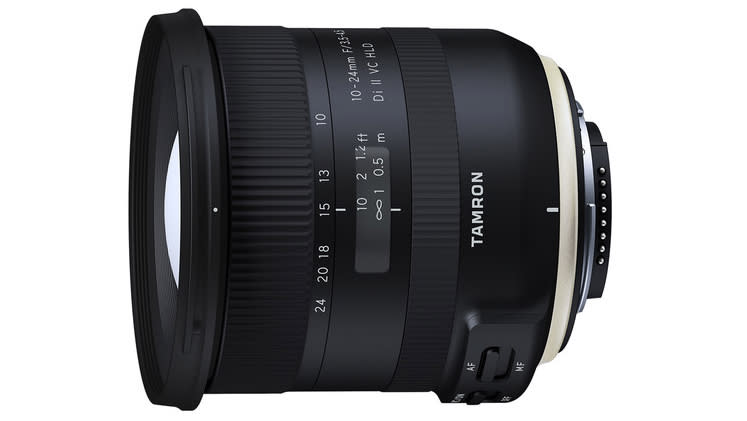
4. Tamron 10-24mm f/3.5-4.5 Di II VC HLD
Another great option for DX Nikons - buy it while you still can
Mount: Nikon F DX | Full-frame compatible: No | Autofocus type: High/Low Torque Drive | Stabilizer: Yes | Minimum focus distance: 0.24m | Filter thread: 77mm | Dimensions: (WxL): 84x85mm | Weight: 440g
Impressive autofocus and stabilization
Generous zoom range
Good build quality with weather seals
Pricier than the original edition
With the rise of mirrorless cameras, we've seen the likes of Sigma and Tamron quietly discontinue many of their APS-C (DX) format DSLR lenses, and this lens is sadly no more. You can still find it at some retailers though, and it could be well worth hunting down.
It boasts improved optical performance over its predecessor, plus a revolutionary HLD (High/Low toque-modulated Drive) autofocus system. Autofocus is faster, quieter and more accurate than before. Handling is improved because the focus ring no longer rotates during autofocus, while also enabling full-time manual override.
The lens also features VC (Vibration Compensation), whereas optical stabilization was lacking in the original lens. Electromagnetic aperture control improves exposure consistency in rapid-fire continuous shooting, although it makes the lens incompatible with some older Nikon DSLRs. Build quality enhancements include a full set of weather seals, plus a fluorine coating on the front element to repel moisture and grease.
In our tests, the Tamron beat many of its rivals in terms of sharpness across the whole image frame, and produced less colour fringing and distortion.
See our full Tamron 10-24mm f/3.5-4.5 Di II VC HLD review
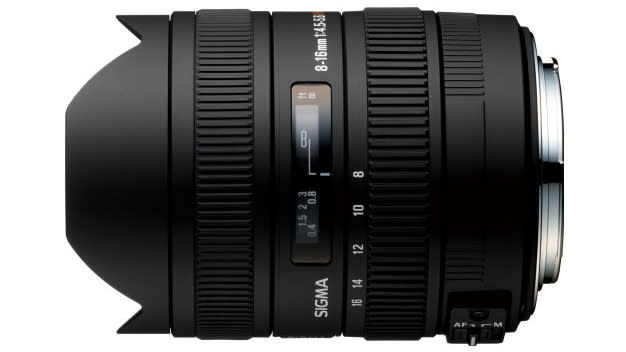
5. Sigma 8-16mm f/4.5-5.6 DC HSM
This lens delivers spectacularly wide viewing angles, if you can find one
Mount: Nikon F DX | Full-frame compatible: No | Autofocus type: Ultrasonic (ring-type) | Stabilizer: No | Minimum focus distance: 0.24m | Filter thread: None | Dimensions (WxL): 75x106mm | Weight: 555g
Supreme viewing angle for DX cameras
Upmarket build quality and performance
Quite expensive
Front mounting filters is tricky
Here's another example of an old lens that's in the process of being phased out. But with no direct replacement, if you want the widest of ultrawide rectilinear zooms for your DX Nikon, you've got little choice but to track down this lens.
Even with just a 2mm advantage over its 10-20mm rivals, the Sigma 8-16mm f/4.5-5.6 DC HSM can suck much more into the image frame. The difference is immediately obvious, and somewhat eye-popping as you look through the viewfinder.
The high-spec optical path includes four top-quality FLD (Fluorite-grade Low Dispersion) elements and Sigma’s Super Multi-Layer Coatings to guard against ghosting and flare. Further defence is offered by the built-in lens hood, but a downside of this is that you can only attach filters to the two-part lens cap, rather than to the lens itself. Try this at anything other than the longest zoom setting and you’ll get extreme clipping of the image corners.
Despite the enormous maximum viewing angle, sharpness is very good across the whole image frame, and both colour fringing and distortions are well controlled. If you want truly epic viewing angles on your DX format DSLR, this Sigma is the lens to buy, while you still can!
See our full Sigma 8-16mm f/4.5-5.6 DC HSM review
Nikon FX wide-angles
The best Nikon wide-angle zoom lenses for Nikon full-frame FX DSLRs, such as the Nikon D850 or the Nikon D780.
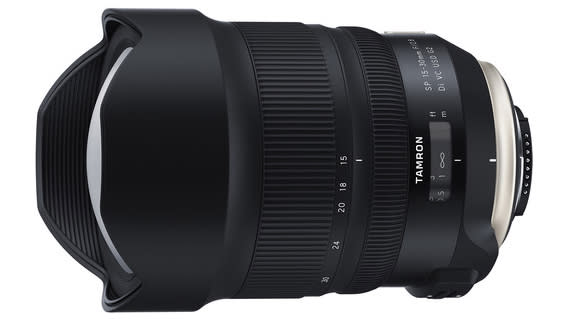
6. Tamron SP 15-30mm f/2.8 DI VC USD G2
A very good ultra-wide zoom range and with optical stabilization too
Mount: Nikon F | Full-frame compatible: Yes | Autofocus type: Ultrasonic (ring-type) | Stabilizer: Yes | Minimum focus distance: 0.28m | Filter thread: None | Dimensions (WxL): 85x145mm | Weight: 1,100g
High-performance autofocus and stabilization
Fast and constant f/2.8 aperture
The G2 is currently 33 per cent pricier than the original
As usual, there’s no filter attachment thread
The original edition of Tamron’s 15-30mm very nearly matched Nikon’s mighty 14-24mm lens for maximum viewing angle, had the same fast and constant f/2.8 aperture rating, but also added optical stabilization. Further attractions included a full set of weather seals and a fluorine coating on the front element. It also massively undercut the Nikon lens for price.
The new G2 (Generation 2) edition represents a major upgrade. The autofocus system is faster and more precise, and the effectiveness of the optical stabilizer increases from 2.5 stops to 4.5 stops. A new high-tech coating is added to the existing nano-structure and conventional coatings, and even the muck-resistant fluorine coating on the front element is improved.
Overall, the G2 lens is better in pretty much every area. It’s a third more expensive to buy than the original lens, but is still very good value for money.
See our full Tamron SP 15-30mm f/2.8 Di VC USD G2 lens review
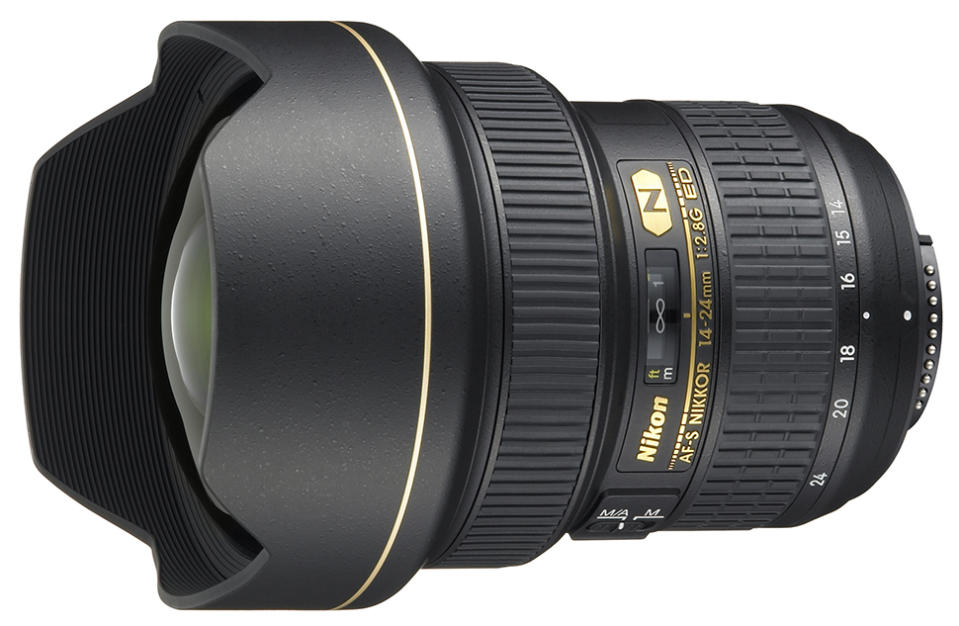
7. Nikon AF-S 14-24mm f/2.8G ED
Nikon's widest full-frame rectilinear zoom lens
Mount: Nikon F | Full-frame compatible: Yes | Autofocus type: Ultrasonic (ring-type) | Stabilizer: No | Minimum focus distance: 0.28m | Filter thread: None | Dimensions (WxL): 96x132mm | Weight: 1,000g
Extreme viewing angle
Fast, constant aperture
Solid build quality
Performance could be better
Expensive to buy
No filter attachment thread
Weighing in at 1kg, the Nikon AF-S 14-24mm packs a mighty maximum viewing angle of 114 degrees. Build quality is of a fully professional standard, complete with weather-seals. The zoom and focus rings are large and have a smooth action, but the relatively short rotational travel of the focus ring makes manual focusing a bit fiddly for applications like astrophotography.
Ring-type ultrasonic autofocus is fast and whisper-quiet, and comes with an ‘M/A’ mode that gives priority to manual focusing while in autofocus mode. It’s an advantage in that you don’t need to wait for autofocus to be achieved before applying manual override. High-grade optics include two ED (Extra-low Dispersion) elements, three aspherical elements, plus nano-structure coatings.
Own-brand lenses from Nikon are often expensive when compared to thrid-party equivalents. It is solidly built and delivers good all-round performance.
See our full Nikon AF-S 14-24mm f/2.8G ED review
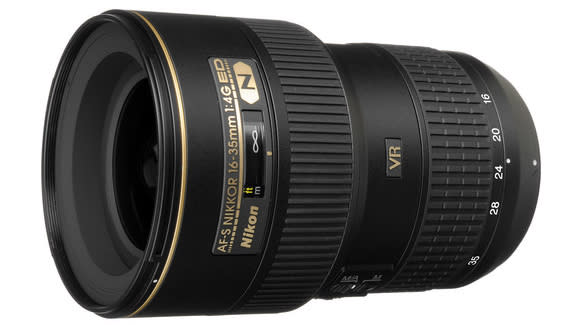
8. Nikon AF-S 16-35mm f/4G ED VR
Relatively compact and light, this is a handy, practical ultra-wide zoom
Mount: Nikon F | Full-frame compatible: Yes | Autofocus type: Ultrasonic (ring-type) | Stabilizer: Yes | Minimum focus distance: 0.2-0.29m | Filter thread: 77mm | Dimensions (WxL): 83x125mm | Weight: 680g
Accepts filters on the front
VR Vibration Reduction built in
Not quite the widest
'Only' f/4 maximum aperture
Noticeably smaller than most other FX format lenses, this Nikon AF-S 16-35mm f/4G ED VR is little more than half the weight of some competitors, thanks to the combination of a relatively modest maximum viewing angle and an f/4 rather than f/2.8 aperture rating. This is also the only FX format lens in the group to feature a filter attachment thread and removable hood.
Two ED (Extra-low Dispersion) elements in the optical path help to optimize image quality, and a Nano Crystal coat minimizes ghosting and flare. Build quality feels very solid, complete with a weather-sealed mounting plate.
Image quality is particularly good at the short end of the zoom range, although sharpness drops off at bit at the long end. The ‘VR’ optical stabilizer is nice to have, especially for shooting in cathedrals, museums and other locations where you might not be allowed to use a tripod. However, it only has a 2.5-stop effectiveness, and is outclassed by the 4.5-stop stabilizer in Tamron’s newer 15-30mm G2 lens.
See our full Nikon AF-S 16-35mm f/4G ED VR review

9. Sigma 14-24mm f/2.8 DG HSM | A
Excellent image quality, no distortion – it's the best FX ultra-wide lens
Mount: Nikon F | Full-frame compatible: Yes | Autofocus type: Ultrasonic (ring-type) | Stabilizer: No | Minimum focus distance: 0.26m | Filter thread: None | Dimensions (WxL): 96x135mm | Weight: 1,150g
Fabulous image quality and all-round performance
It’s virtually a distortion-free lens
Typically large, heavyweight build
Built-in hood so there’s no filter thread
Compared with Sigma’s slightly older 12-24mm Art lens, the has a more modest maximum viewing angle but a faster aperture rating. The net result is that both lenses have a practically identical size and weight. The starring optical attraction is an ultra-high-precision moulded glass aspherical front element, which represents a considerable manufacturing challenge. Further optical highlights include three FLD (Fluorite-grade Low Dispersion) and three SLD (Special Low Dispersion) elements.
The consummately pro-grade build has a high-precision yet very robust feel throughout. There’s a full set of weather seals, plus a keep-clean fluorine coatings on the front and rear elements.
Contrast and sharpness are marvellous, the latter being maintained very well out to the corners of the frame, even when shooting wide-open at f/2.8. Even more impressively, colour fringing and distortions are absolutely negligible. Overall image quality beats that of Nikon’s pricier 14-24mm lens, making the Sigma an absolute bargain.
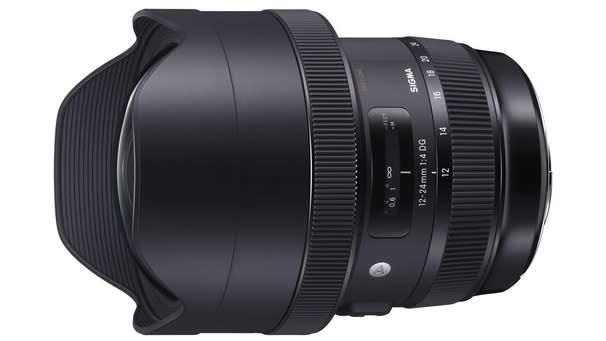
10. Sigma 12-24mm f/4 DG HSM | A
Not quite the best optically, but an incredible angle of view
Mount: Nikon F | Full-frame compatible: Yes | Autofocus type: Ultrasonic (ring-type) | Stabilizer: No | Minimum focus distance: 0.24m | Filter thread: None | Dimensions (WxL): 102x132mm | Weight: 1,150g
Incredible viewing angle for a non-fisheye lens
Great performance, minimal distortion
Bigger and heavier than the previous Mk II edition
Only the mounting plate is weather sealed
We were always fond of Sigma’s 12-24mm Mark II lens, which delivered a monstrous maximum viewing angle along with good overall image quality and performance. The from Sigma’s Global Vision range ups the stakes, with a constant rather than variable aperture rating.
The optical path is refined and incorporates an extra-large diameter aspherical element, along with five top-class FLD (Fluorite-grade Low Dispersion) elements. The mounting plate gains a weather seal and fluorine coatings have been added to the front and rear elements. The new lens retains a ring-type ultrasonic autofocus system, but it has extra torque for improved performance. Another notable upgrade is that the Art lens is compatible with Sigma’s optional USB Dock for applying firmware updates and fine-tuning. The only downside is that it’s rather bigger and heavier than the previous edition.
Image quality is excellent, despite the extravagant maximum viewing angle, and there’s much less distortion than from the previous Mk II lens, although it’s not as ‘distortion-free’ as Sigma’s newer 14-24mm Art lens. Even so, this is the lens to get for ultra-wide-angle coverage.
Nikkor Z wide-angles
The best Nikon wide-angle zoom lens for Nikon Z mount mirrorless cameras, such as the Nikon Z 50, Z 6 , Z 7, Z6 II, Z7 II, and Z9.
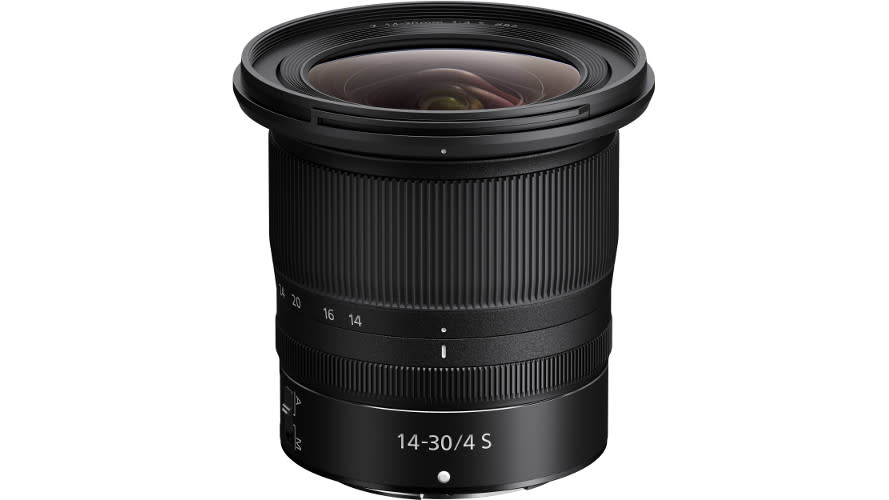
11. Nikkor Z 14-30mm f/4 S
It's 'only' an f/4, but image quality is great and it's really compact
Mount: Nikon Z | Full-frame compatible: Yes | Autofocus type: Stepping motor | Stabilizer: No | Minimum focus distance: 0.28m | Weight: 485g
Outstanding image quality
Lightweight
Only f/4 maximum aperture
No stabilizer
This wide-angle is designed specifically for the Nikon Z series of full-frame mirrorless cameras, and although it has a slightly disappointing maximum aperture of f/4, it does have internal optics that ensure pin-sharp image quality. It has 14 elements in total, split into 11 groups, and the control ring can be assigned to the user's preferred functions such as focus, ISO, exposure compensation, etc.
The stepping motor autofocus system is fast, accurate and practically silent, meaning the lens is a solid choice for videos as well as stills. The lens is also nice and lightweight, suiting the Z-mount mirrorless cameras perfectly, and if you're a user of Nikon DSLRs and would like to give it a try, you can pick up the .
Providing superb sharpness and excellent operability, the Nikon Nikkor Z 14-30mm f/4 S is an extremely solid lens all-around, as long as you can live with that f/4 maximum aperture.
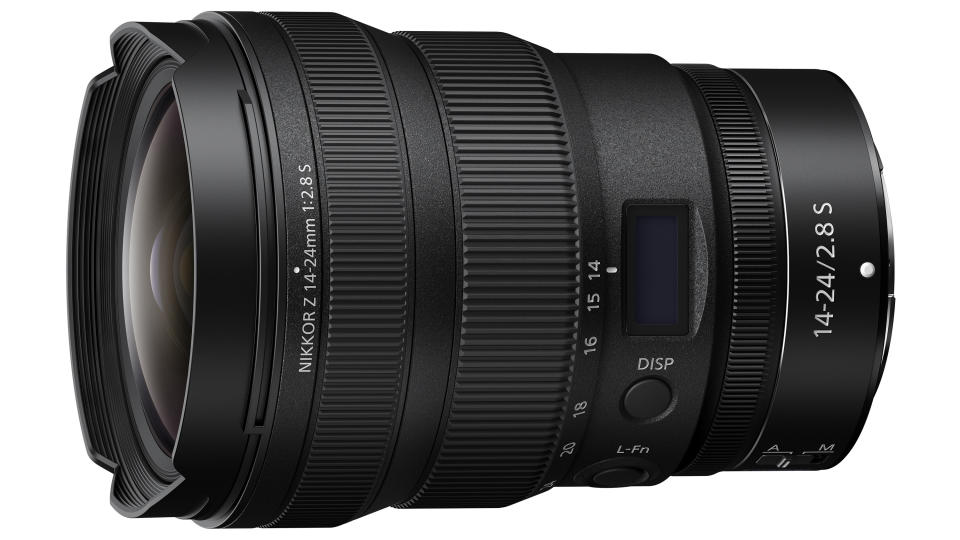
12. Nikkor Z 14-24mm f/2.8 S
This is Nikon's pro ultra-wide zoom for its full frame Nikon Z cameras
Mount: Z FX | Autofocus: Pulse (stepping motor) | Stabilizer: None | Min focus distance: 0.28m | Max magnification: 0.13x | Filter thread: 112mm (plus rear filter slot) | Dimensions (WxL): 88x124.5mm | Weight: 650g
Uncompromising optics and coatings
Fast constant aperture
Fully weather sealed
Twice the price of Z 14-30mm f/4 S...
... and significantly heavier and longer
No VR
The Nikkor Z 14-24mm f/2.8 S is Nikon's latest effort to attract pros to the Z mount system. Completing the holy trinity of fast f/2.8 S-line zooms, it slots in neatly next to the Nikkor Z 24-70mm f/2.8 S and promises uncompromising wide-angle image quality. The 16-element optical stack includes 3 aspherical elements, along with Nikon’s Nano Crystal and ARNEO Coat for reducing ghosting and flare. The front element gets a smear-resistant flourine coating, and the lens is fully weather sealed. Add the included HB-98 lens hood and huge 112mm filters can be used – Nikon offers Neutral Colour and Circular Polarizer options.
Read more: Nikkor Z 14-24mm f/2.8 S review
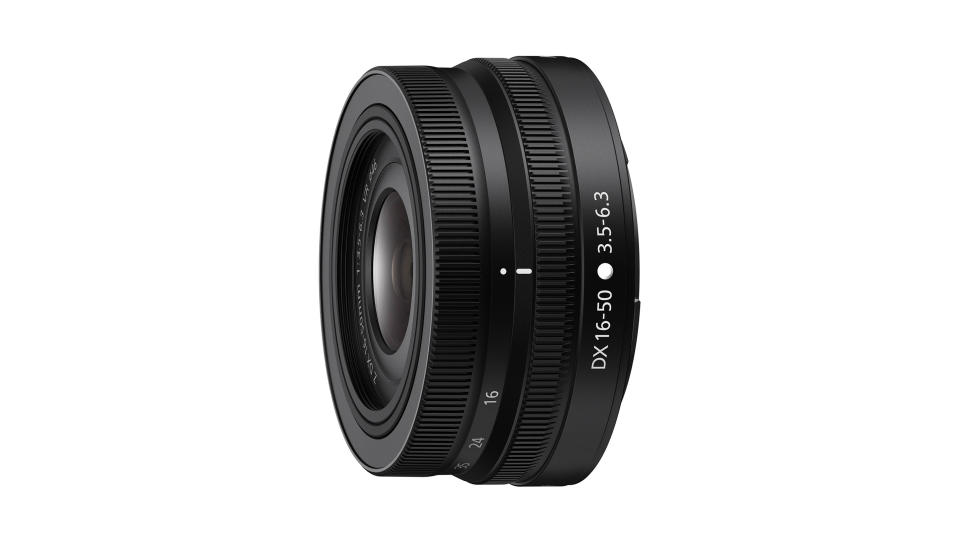
13. Nikkor Z DX 16-50mm f/3.5-6.3 VR
Remarkably small, this is the best wide-angle zoom for Z50
Mount: Z DX | Autofocus: Pulse (stepping motor) | Stabilizer: 4.5-stop | Min focus distance: 0.25-0.3m | Max magnification: 0.2x | Filter thread: 46mm | Dimensions (WxL): 70x32mm | Weight: 135g
4.5-stop optical VR
Multi-function control ring
A silver version matches the Nikon Z fc
‘Slow’ f/6.3 long-zoom aperture
Feels a bit plasticky
Tipping the scales at just 135g, this DX (APS-C) format standard zoom for the Z50, Z30 and Z fc pretty much qualifies as a ‘pancake lens’, measuring a mere 32mm in length when retracted. The flip-side is that, compared with weightier FX (full-frame format) Z-mount lenses, it feels a bit less solid and has a plastic rather than metal mounting plate. Even so, it’s certainly robust enough for daily shooting. Like most similarly priced APS-C format cameras, the Z50 and Z30 lack IBIS (In Body Image Stabilization) but the lens comes to the rescue with 4.5-stop optical VR (Vibration Reduction). Although small in size, the little Nikkor punches above its weight, delivering great sharpness and contrast even when shooting wide-open, which is just as well considering that the widest available aperture shrinks to f/6.3 at the long end of the zoom range. A silver version of this lens is now available, to match the retro styling of the Nikon Z fc.
How we test lenses
We test lenses using both real world sample images and lab tests. Our lab tests are carried out scientifically in controlled conditions using the Imatest testing suite, which consists of custom charts and analysis software that measures resolution in line widths/picture height, a measurement widely used in lens and camera testing. We find the combination of lab and real-word testing works best, as each reveals different qualities and characteristics.
Read more:
• The best Nikon lenses
• The best fisheye lenses
• The best wideangle lenses
• Best lens for street photography: best 35mm lenses
• 10 tips on getting the best out of your Nikon camera
• The best Nikon camera bag

